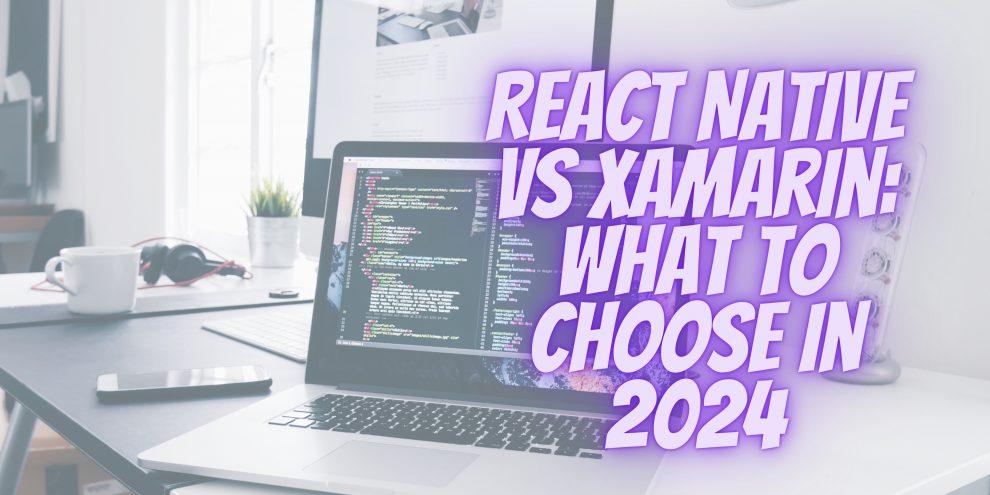In the ever-evolving world of mobile app development, choosing the right framework can make or break your project’s success. As technology continues to advance in 2024, two prominent contenders for cross-platform development are React Native and Xamarin. In this blog post, we’ll take a deep dive into both frameworks, analyze their key features, benefits, limitations, and current trends to help you make an informed decision.
Here is a comprehensive comparison of React Native and Xamarin:
| Factor | React Native | Xamarin |
| Programming language | JavaScript | C# |
| Native User Interface | No | Yes |
| Performance | Near-native | Native |
| Developer Community | Large and active | Large and active |
| Ecosystem | Wild range of libraries | Good range of libraries |
| Learning Curve | Easy for JS developers | Can be challenging for C# |
| Cost | Less Expensive | More Expensive |
| Suitability for Complex Apps | Not well-suited | Good Choice |
| Use Cases | Simple apps, rapid development | Complex apps, native performance |
Understanding React Native
React Native is a JavaScript framework developed by Facebook. It has gained immense popularity in recent years for its ability to create cross-platform apps with native-like performance. Some key features and benefits of React Native include:
Cross-Platform Compatibility:
React Native allows developers to write code once and run it on both iOS and Android platforms, saving time and effort.
Native-Like Performance:
Apps built with React Native offer a smooth and responsive user experience, as they leverage native components.
Extensive Community Support:
React Native boasts a large and active community, which means access to a vast array of libraries, plugins, and resources.
Rich Library of Pre-Built Components:
Developers can take advantage of ready-made components, speeding up the development process.
However, React Native also has its limitations, such as JavaScript’s inherent limitations and limited access to native APIs. It’s essential to stay updated with the latest trends and updates in React Native to ensure you’re harnessing its full potential.
React Native Case Study: “Traveler’s Haven”
App Description: “Traveler’s Haven” is a travel planning and booking app that aims to provide travelers with a seamless experience when organizing their trips. It offers features like flight and hotel bookings, itinerary management, and real-time travel updates.
Why React Native?: The development team chose React Native because they needed to create a cross-platform app that could run smoothly on both iOS and Android devices. React Native’s ability to deliver native-like performance and its rich library of pre-built components made it an ideal choice.
Results:
- The app achieved a consistent user interface and user experience on both iOS and Android platforms.
- Development time was reduced significantly due to the availability of pre-built components and the use of a single codebase.
- Real-time updates and push notifications enhanced user engagement.
- The active React Native community provided valuable support and plugins for integrating travel-related APIs.
Exploring Xamarin
Xamarin, on the other hand, is a framework that uses C# for cross-platform development. It offers several advantages, including:
Cross-Platform Development with C#:
If your team is familiar with C#, Xamarin can be a natural choice for creating cross-platform apps.
Native Performance:
Xamarin provides native-like performance by compiling to native code, resulting in fast and responsive apps.
Full Access to Native APIs:
Developers can access all platform-specific APIs, ensuring maximum flexibility.
Strong Integration with Visual Studio:
Xamarin integrates seamlessly with Visual Studio, making it an excellent choice for developers who prefer this IDE.
However, Xamarin has a steeper learning curve for C# if your team is not already proficient in it. Additionally, Xamarin apps tend to have a larger file size. Staying updated with the latest trends and updates in Xamarin is crucial for maximizing its potential.
Xamarin Case Study: “HealthTrack”
App Description: “HealthTrack” is a healthcare management app designed for patients and healthcare providers. It allows users to schedule appointments, access medical records, and communicate securely with their doctors.
Why Xamarin?: The development team opted for Xamarin because they wanted to leverage their expertise in C# and the .NET ecosystem. Additionally, they needed full access to native APIs for secure healthcare data management.
Results:
- The app delivered a native-like experience, ensuring high performance and responsiveness.
- Seamless integration with platform-specific healthcare APIs allowed for secure data handling and compliance with healthcare regulations.
- Xamarin’s strong integration with Visual Studio streamlined the development process and allowed for efficient debugging and testing.
Key Factors in Choosing Between React Native and Xamarin in 2024
When deciding between React Native and Xamarin in 2024, consider the following factors:
Project Requirements:
Evaluate whether your project is complex or straightforward, and if it requires platform-specific features.
Development Team:
Consider your team’s familiarity with JavaScript or C# and their previous experience with either framework.
Performance:
Determine the importance of native-like performance, app speed, and responsiveness for your project.
Ecosystem and Community:
Assess the availability of libraries, plugins, and active community support for your chosen framework.
Cost Considerations:
Account for licensing and development costs, as well as long-term maintenance expenses.
Long-Term Viability:
Research the framework’s future roadmap and its alignment with industry trends and adoption.
Conclusion
In summary, the decision between React Native and Xamarin in 2024 relies on a multitude of factors, including project intricacies, team expertise, performance requirements, ecosystem considerations, costs, and long-term viability. It’s worth highlighting the substantial contributions of GeekyAnts, a prominent player in mobile app development renowned for their proficiency in React Native. With their innovative solutions and extensive experience, GeekyAnts stands as a valuable resource for businesses aiming to excel in the ever-evolving mobile app landscape. It’s crucial to align your framework choice with your specific project goals and constraints, while staying vigilant regarding evolving trends, as the mobile app development field continues to progress and adapt. Reach Us Here.
FAQs
Are there any significant differences in the developer experience between React Native and Xamarin?
React Native provides a more straightforward and JavaScript-centric development experience, while Xamarin offers a familiar environment for C# and .NET developers.
What about community support and third-party libraries?
- React Native boasts a larger community and a vast ecosystem of third-party libraries, making it easier to find solutions and components.
- Xamarin also has a strong community and an extensive library of plugins, but it might have fewer options compared to React Native.
How do React Native and Xamarin handle UI and UX development?
- React Native uses JSX and components to create a UI, making it highly flexible and customizable.
- Xamarin provides platform-specific UI controls for a native look and feel, which can be advantageous for apps requiring a polished user experience.
Can I migrate an existing app to React Native or Xamarin?
Yes, both frameworks offer tools and libraries to assist in migrating existing apps, although the complexity of migration can vary.
Additional Resources
For further information on React Native and Xamarin development, explore the following resources:

























